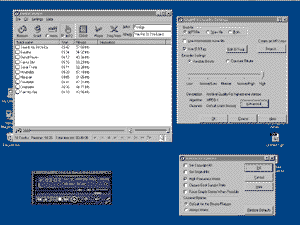Hardware
Audio
Controllers
General
Mainboards
Modems
Monitors
Portables
Printers
Processors
Scanners
Storage
Video
Games
Reviews
Previews
Cheats
& Hints
News
General Info
MPEG 1 Layer 3 (MP3) - Normal QualityThis allows for files which can compete in size with other encoders but still maintain greater quality. Think of most other current encoders as maintaining constant bitrate and thereby having variable quality throughout the stream. Variable bit rate does the opposite and maintains constant quality throughout the stream. I have included a link to a very good explanation of the subject on the Phillips web site (see the conclusion page). Note, however, that MP3s have a bit rate limit of 160 kbps per channel. For the purpose of this comparison, I used the Xing encoder in two different modes (other than using it as the CD ripper). For the Normal Quality level, I used a setting of 160 kbps Constant Bit Rate (CBR), joint stereo (M/S stereo) and with the high frequency option disabled. This brings down the maximum frequency to 16 kHz. Now before shouting at me for this, consider the fact that the normal setting is not for very high-end hardware and that most such speakers cannot produce much more than 16 kHz. For the High Quality setting I use the "High" Variable Bit Rate setting with the high frequency option enabled. Joint stereo was enabled (following the instructions of the manual). Keep in mind that while I have used Winamp to playback for this test, the Sonique player sounds a lot better. Observations - Normal QualityThe quality seems to be of the same class as MS Audio but the artefacts not as annoying. The quality level can be further increased by using variable bit rate at the "high/normal" level but we have not used that here.
(If you have a problem downloading these files right click on them and select save as) The music encoded at this level didn't really exhibit compression artefacts but you could tell that it is not as good as the original. At times the dynamic range would seem to be not as much and other times different sounds were emphasized. Overall we agree that this is a very good technology plus setting for everyday use unless you have high quality audio equipment. (Rating: B+)
Observations - High Quality
(If you have a problem downloading these files right click on them and select save as) We came across a big surprise when encoding the Alanis Morissette CD. Even though we were expecting file sizes to stay around those of 192 kbps, we got some files which were more in line with 160 if not 128 kbps. This, folks, is VBR in action. And this is enough for a lot of people to consider using this over the MP2 technology which has a slight edge in quality probably due to a very polished acoustic perceptual model. Overall we had no complaints over the quality here and had to repeatedly listen to sections of music to really compare it with MP2. Another thing we noticed was that the MP2 was suffering at a few rare points. We did not see that happen here because the bitrate just goes up in such places. This may actually make this a more enjoyable listening experience. Well done to Xing for moving the MP3 technology scene along in at a time when most people have stopped working on it. (Rating: A)
|
|
|
|
|
